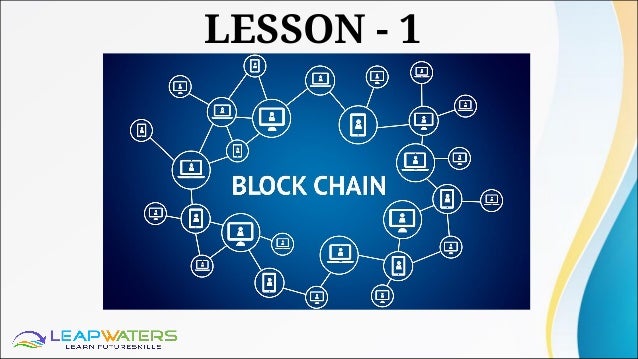LESSON 1 WHAT IS BLOCKCHAIN & HOW BLOCKCHAIN WORKS _.pdf
•
0 likes•3 views
Blockchain is a system of recording information in a way that makes it difficult or impossible to change, hack, or cheat the system. A blockchain is essentially a digital ledger of transactions that is duplicated and distributed across the entire network of computer systems on the blockchain.
Report
Share
Report
Share
Download to read offline

Recommended
Recommended
More Related Content
Similar to LESSON 1 WHAT IS BLOCKCHAIN & HOW BLOCKCHAIN WORKS _.pdf
Similar to LESSON 1 WHAT IS BLOCKCHAIN & HOW BLOCKCHAIN WORKS _.pdf (20)
Concept of Blockchain Technology - How Does It Work (1).pdf

Concept of Blockchain Technology - How Does It Work (1).pdf
More from Leapwaters
More from Leapwaters (12)
LESSON 2 BLOCKCHAIN DECENTRALIZATION _ DATAFICATION IN BLOCKCHAIN TECHNOLOGY ...

LESSON 2 BLOCKCHAIN DECENTRALIZATION _ DATAFICATION IN BLOCKCHAIN TECHNOLOGY ...
LESSON 3 BLOCKCHAIN TRANSPARENCY _ BLOCKCHAIN SECURITY _ BITCOIN VS BLOCKCHAI...

LESSON 3 BLOCKCHAIN TRANSPARENCY _ BLOCKCHAIN SECURITY _ BITCOIN VS BLOCKCHAI...
Recently uploaded
Mehran University Newsletter is a Quarterly Publication from Public Relations OfficeMehran University Newsletter Vol-X, Issue-I, 2024

Mehran University Newsletter Vol-X, Issue-I, 2024Mehran University of Engineering & Technology, Jamshoro
Recently uploaded (20)
SECOND SEMESTER TOPIC COVERAGE SY 2023-2024 Trends, Networks, and Critical Th...

SECOND SEMESTER TOPIC COVERAGE SY 2023-2024 Trends, Networks, and Critical Th...
Presentation by Andreas Schleicher Tackling the School Absenteeism Crisis 30 ...

Presentation by Andreas Schleicher Tackling the School Absenteeism Crisis 30 ...
Measures of Central Tendency: Mean, Median and Mode

Measures of Central Tendency: Mean, Median and Mode
Unit-V; Pricing (Pharma Marketing Management).pptx

Unit-V; Pricing (Pharma Marketing Management).pptx
This PowerPoint helps students to consider the concept of infinity.

This PowerPoint helps students to consider the concept of infinity.
Mixin Classes in Odoo 17 How to Extend Models Using Mixin Classes

Mixin Classes in Odoo 17 How to Extend Models Using Mixin Classes
Web & Social Media Analytics Previous Year Question Paper.pdf

Web & Social Media Analytics Previous Year Question Paper.pdf
Z Score,T Score, Percential Rank and Box Plot Graph

Z Score,T Score, Percential Rank and Box Plot Graph
LESSON 1 WHAT IS BLOCKCHAIN & HOW BLOCKCHAIN WORKS _.pdf
- 1. LESSON - 1
- 2. WHAT IS BLOCKCHAIN? A blockchain is a distributed database that is shared among the nodes of a computer network. As a database, a blockchain stores information electronically in digital format. Blockchains are best known for their crucial role in cryptocurrency systems, such as Bitcoin, for maintaining a secure and decentralized record of transactions. The innovation with a blockchain is that it guarantees the fidelity and security of a record of data and generates trust without the need for a trusted third party.
- 3. One key difference between a typical database and a blockchain is how the data is structured. A blockchain collects information together in groups, known as blocks, that hold sets of information. Blocks have certain storage capacities and, when filled, are closed and linked to the previously filled block, forming a chain of data known as the blockchain. All new information that follows that freshly added block is compiled into a newly formed block that will then also be added to the chain once filled.
- 4. A database usually structures its data into tables, whereas a blockchain, like its name implies, structures its data into chunks (blocks) that are strung together. This data structure inherently makes an irreversible time line of data when implemented in a decentralized nature. When a block is filled, it is set in stone and becomes a part of this time line. Each block in the chain is given an exact time stamp when it is added to the chain.
- 5. KEY POINTS 1- Blockchain is a type of shared database that differs from a typical database in the way that it stores information; blockchains store data in blocks that are then linked together via cryptography. 2- As new data comes in, it is entered into a fresh block. Once the block is filled with data, it is chained onto the previous block, which makes the data chained together in chronological order. 3- Different types of information can be stored on a blockchain, but the most common use so far has been as a ledger for transactions. 4- In Bitcoin’s case, blockchain is used in a decentralized way so that no single person or group has control—rather, all users collectively retain control.
- 6. 5- Decentralized blockchains are immutable, which means that the data entered is irreversible. For Bitcoin, this means that transactions are permanently recorded and viewable to anyone.
- 7. The goal of blockchain is to allow digital information to be recorded and distributed, but not edited. In this way, a blockchain is the foundation for immutable ledgers, or records of transactions that cannot be altered, deleted, or destroyed. This is why blockchains are also known as a distributed ledger technology (DLT). First proposed as a research project in 1991, the blockchain concept predated its first widespread application in use: Bitcoin, in 2009. In the years since, the use of blockchains has exploded via the creation of various cryptocurrencies, decentralized finance (DeFi) applications, non-fungible tokens (NFTs), and smart contracts. HOW DOES BLOCKCHAIN WORK ?
